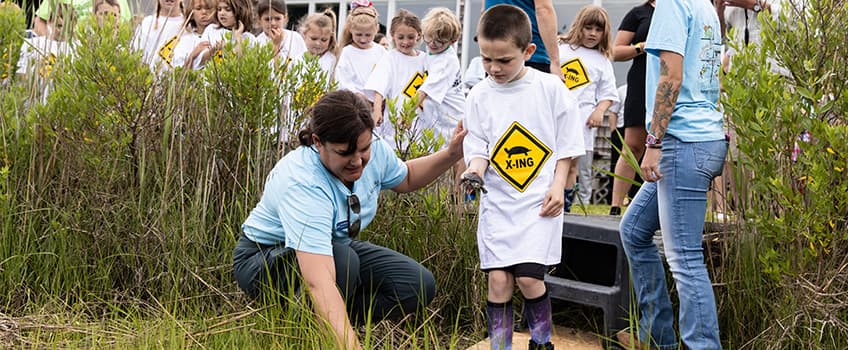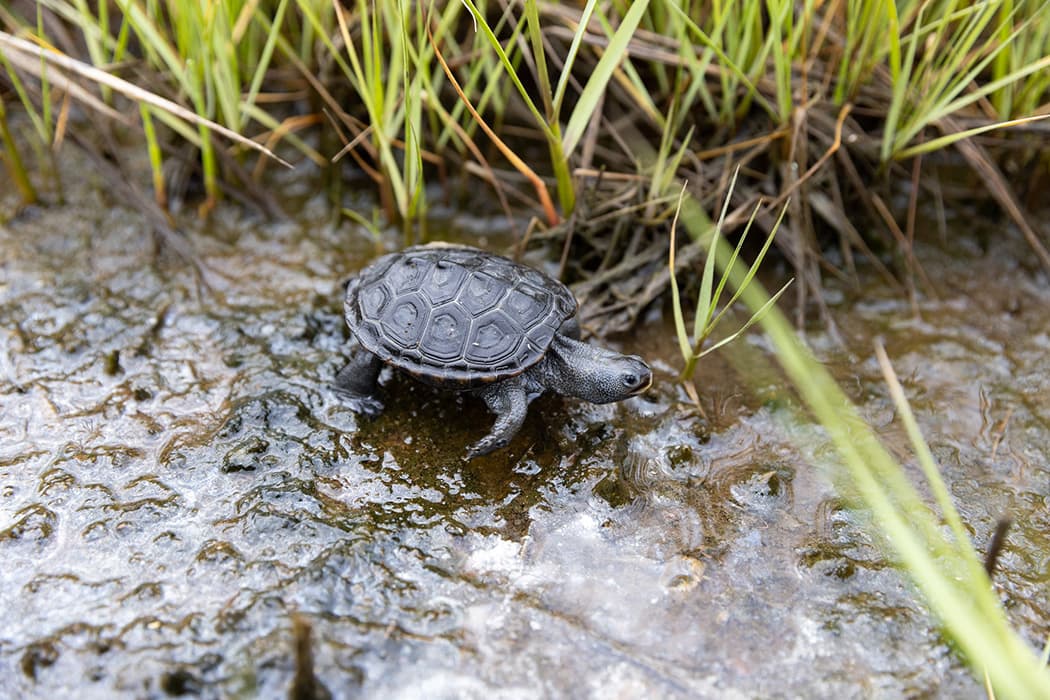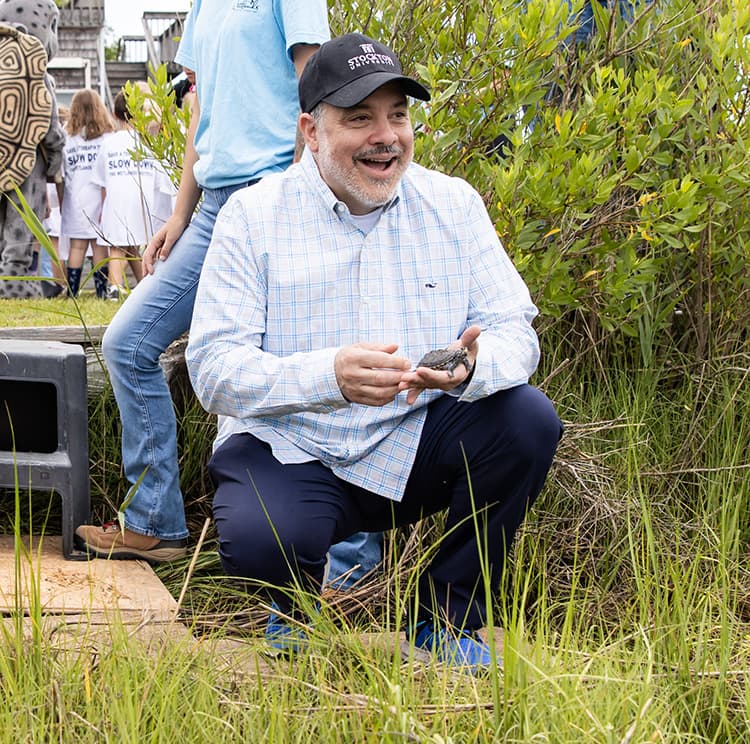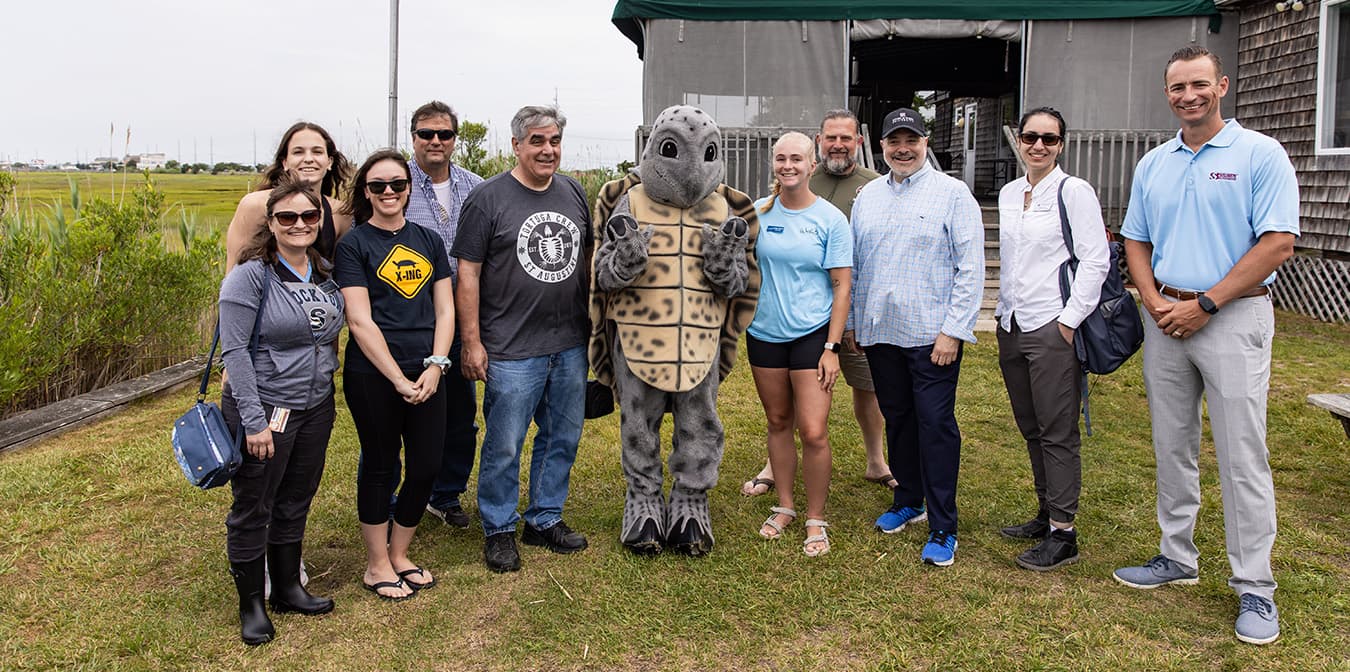Rescue Project Gives Terrapins New Life

Lisa Ferguson, the Wetlands Institute director of Research and Conservation, helps Reed Herr, 6, place a terrapin that had been raised in Stockton's Animal Lab back into the marsh next to the institute on June 5.
Middle Township, N.J. — Reed Herr carefully stepped down into the marsh. The 6-year-old tightly grasped a 3-inch terrapin that had been raised in Stockton University’s Animal Lab, and he eagerly awaited his chance to return it to the wild.
“Do you have a name for your turtle?” asked Lisa Ferguson, the Wetlands Institute’s director of Research and Conservation.
“Puddles!” Herr replied with a smile on his face.
He proudly wore a new T-shirt with the words “Save a terrapin today. SLOW DOWN” emblazoned on the back and a turtle “X-ING” sign on the front.
“Puddles is our first turtle to go back into the marsh!” Ferguson announced as Herr waved goodbye to the turtle he placed in the tall grass next to the institute.
 Somewhere between 500 and 1,000 terrapin turtles are rehabilitated annually at Stockton's
Animal Lab as part of the Diamondback Terrapin Rescue Project.
Somewhere between 500 and 1,000 terrapin turtles are rehabilitated annually at Stockton's
Animal Lab as part of the Diamondback Terrapin Rescue Project.
Puddles was just one of hundreds of injured turtles collected annually by the institute and nurtured and rehabbed by Stockton students and staff as part of the Diamondback Terrapin Rescue Project. The project was started more than 30 years ago by Roger Wood, a former Stockton faculty member and a former research director at the Wetlands Institute.
“I just think this is so cool. I wish more schools could do it,” said Samantha Gilbert, Herr’s kindergarten teacher at Stone Harbor Elementary School. The 2022 Stockton graduate brought her class of 14 students to the institute as part of an annual tradition to release terrapins back to their natural habitat.
“We are so lucky here. I just feel like it’s a perfect experience for young kids to get into nature because we are in such a technological generation,” said Gilbert, whose bachelor’s degree was in Liberal Arts and Education. “I think we need to get back in touch with our natural world.”
Getting children engaged in conservation at a young age is one of the main tenets of the project, said Brian Williamson, a research scientist at the institute.
“Ever since the beginning of our terrapin project, we’ve really been involving the community, and starting young really helps build that foundation that people carry forward throughout their whole lives,” he said.
He added that adults routinely come back to the institute to say that as kindergarteners they released a turtle back to the marsh as part of the project and ever since they will stop to help turtles when they see them in need.
Williamson’s primary job is to work with diamondback terrapins. He oversees twice-a-day road surveys by volunteers and student interns during the peak nesting season, which runs from late May to the end of July. Stockton student Darby Brant is one of the interns driving the main roads between Stone Harbor and Ocean City looking for injured and dead terrapins that have been hit by cars.
“We try and get them off the roadways and get as many saves as possible,” said the senior Marine Science major from Langhorne, Pennsylvania. “For roadkills, we can find out if they have eggs and if so, we can remove those eggs and incubate them. Once they hatch we take them to Stockton to raise them.”
The turtles, often no bigger than a coin, are taken to John Rokita, Lester Block, Melissa Laurino and others in Stockton’s Animal Lab, which has permits from the state to rehab the turtles. They work with students like Adrianna McGinty to rehabilitate between 500 and 1,000 turtles a year and get them healthy enough to be returned home. They also incubate the eggs at a specific temperature to all be females, since those are the turtles that are most often killed on area roads.

Stockton University President Joe Bertolino places one of the rescued terrapins into the marsh next to the Wetlands Institute near Stone Harbor.
“We get a lot of car-hit females. If they are alive and doing well, we do our best to patch them up,” said McGinty, a senior Biology major from Galloway. She and other lab employees use an epoxy to repair the shells as best as they can. “We take care of them until they can take on deep water again. Then once we see that they are eating, swimming and healthy again, they’ll be released to the wild.”
Some of the turtles only need to stay for a few weeks or months, others can be in the lab for years, Rokita said. Once the terrapins are healthy, the Animal Lab works with different groups, like the institute, to release them back into the wild. Before the 2- to 3-inch turtles were given to the kindergarteners on June 5, Williamson implanted the terrapins with a microchip in one of their armpits to help researchers track the number of times they return to the institute.
“We’ve seen multiple turtles come back to nest on our property,” Williamson said, adding that it’s great to have Stockton’s continued support of the program.
“The university has been incredibly important to our success with our conservation efforts,” Williamson said. “There aren’t many options in South Jersey. Stockton is the primary head-starting facility for our project. They raise more turtles than anyone else. We are really happy to get a lot of healthy turtles from them every year.”
As McGinty watched Williamson scan a previously tagged terrapin, she was also happy to see the benefits of her work in the lab.
“It’s nice to see the terrapins get released because we’ve been taking care of them for the past year. It’s nice to see our work get to go out in the wild again,” she said. “They said that one was released in the last two years, so it’s cool to think that may have been one of the ones that I helped raise in the animal lab.”
— Story by Mark Melhorn, photos by Susan Allen



